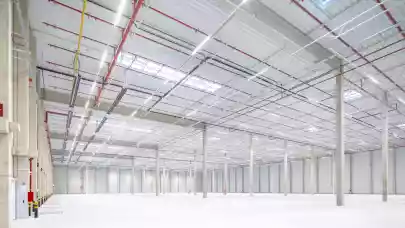
The past year has been an extremely intense one for the housing market. A series of events from another Covid-19 wave, the outbreak of war in Ukraine and the ensuing influx of refugees, to the acceleration of inflation, a tightening of credit scoring criteria, the increase in interest rates and the coming into force of the Law of the Developer's Guarantee Fund, have significantly affected the market. These changes will certainly continue to resonate in 2023. JLL experts summarize what the coming months may have in store for the housing market.
The past year has been marked by shocks to the Polish housing market. January brought another wave of the Covid-19 pandemic. In February, the war in Ukraine broke out triggering an influx of refugees into Poland and beyond, rising inflation, and a dramatic increase in the level of uncertainty in the global economy. In April, a new rule for calculating creditworthiness came into force, requiring banks to add five percentage points to interest rates when calculating creditworthiness. As a consequence, credit demand, constrained already by increases in interest rates, was further dampened.
The impending entry into force of the Law of the Developer's Guarantee Fund caused new investments, whose sales probably would have waited for more favourable market conditions, to be put on the market at the end of June. Subsequent rate increases were reflected in the interest rates on prospective mortgages, which by the end of the year, were in the 9-10% range. At the same time, interest rates on development loans rose to 12-13%. The number of newly issued mortgages declined to just over 6,000 per month nationwide, a 75% drop on the record months of last year. Although inflation was approaching 18% in the autumn, wage increases failed to keep pace. Consumer sentiment deteriorated, as did business-related indexes, and forecasts began to predict a recession in 2023.
Market reaction
Unlike 2008-2009, when Poland was on the periphery of the global financial crisis, this time the country finds itself at the epicentre of 2022’s crisis. Against this backdrop, the fall in real estate sales seen in the largest metropolitan areas in Q4 2022, were comparable to those in 2010-12 and can therefore be regarded as a moderate decline.
”The development industry reacted quite calmly, reducing supply and limiting new construction in the second half of the year. There were various incentives for buyers. Development companies entered 2022 in good financial shape, and investments in progress had high levels of units sold. In addition, credit vacations helped borrowers to maintain liquidity. However, the decline in sales is a threat to investments started in 2022, unless sales start to pick up quickly. For now, however, the number of finished units which in major cities are unsold is small - between 6% and 17%. It is worth recalling that after the previous crisis it exceeded a third of the offer in several cities", said Aleksandra Gawronska, Director of Residential Market Research, JLL.
Cash is king
The decline in sales varied across market segments. It was most pronounced in those segments and locations where buyers using mortgage loans had previously dominated.
"Where purchases were financed with cash, the fall in sales was less significant. As in any crisis, ‘cash has proved to be king’. More expensive apartments in good locations, as well as the smallest units suitable for rent, sold reasonably well. In contrast, sales of three- and four-room apartments in less attractive locations slowed considerably. The mortgage crisis reminded us that the lack of new loans hampers sales in the primary market not only directly, but also through the secondary market. This is because a number of buyers of new apartments are part of a property chain, meaning they have to sell their existing apartment to finalize the purchase of a new property," adds Kazimierz Kirejczyk, Chairman of the Strategic Advisory Panel, JLL.
Record surplus of permits
2022 will most likely be a record year in terms of the number of apartments completed, although the final result will probably be close to last year's. Certainly, the difference in the number of apartments for which developers have obtained permits and whose construction has begun - possibly close to 80,000 in Poland - will be a record. Surpluses were also significant in 2020 and 2021, which is why today the number of apartments on unused permits can be estimated at approx. 160,000 which is almost as many as developers started building in Poland during 2021’s record performance. On the one hand, this means that if the crisis ends quickly, demand picks up and financing costs fall, developers will be able to quickly increase supply. On the other hand, some companies have placed their financial reserves in land and documentation, and as the crisis continues, they may run out of cash.
The PRS market
Declines in apartment sales generally mean an increase in demand in the rental market. This demand peaked in the first half of the year with the influx of Ukrainian refugees following the outbreak of war resulting in the rental of almost all available units. In the middle of the year, rents rose by about 30-40% compared to the previous year, which meant an increase in rental profitability for those who bought properties in recent years at lower prices.
"2022 was also a time when the performance of the emerging institutional rental market sector stalled. The high cost of financing and the difficulty of determining the cost of investment, as well as the perception of Poland as a market with an increased geopolitical risk, caused negotiations for the purchase of buildings for lease to be suspended, although the number of developers interested in selling did increase. In 2021, there was little interest from developers in selling investments to funds but by the end of 2022 market sentiment had done a complete 180", comments Aleksandra Gawronska, an expert at JLL.
What will 2023 bring?
Kazimierz Kirejczyk stresses that "the situation in the housing market in 2023 will depend on the geopolitical and macroeconomic environment. A prolonged war, especially if accompanied by a cold winter, will mean problems with inflation, public debt, the labour market and financing costs. On the other hand, a moderately mild winter will result in a drop in energy commodity prices and would therefore contribute to lower inflation. In addition, a possible ceasefire in Ukraine would be a very positive stimulus both for reducing the scale of risks and having a positive impact on buyer sentiment."
The housing loan market
The level of loans in the second half of 2022 could provide a good benchmark for the first half of 2023. Interest rate changes should already be small with the market becoming more accustomed with their level with each passing month.
"However, the government has announced a new program to support purchases for homeownership, "First Housing". This means that in the short term, demand for loans will fall even more sharply. Not only will more banks suspend WIBOR-based lending, with some buyers waiting for some time for WIRON-based offers to appear and perhaps for KNF to lower the prudential buffer, but eligible buyers of first apartments will hold off on buying until new loans under the “First Housing” program are in place. It looks like we are in for six months of a "strategic credit pause", Kazimierz Kirejczyk comments.



